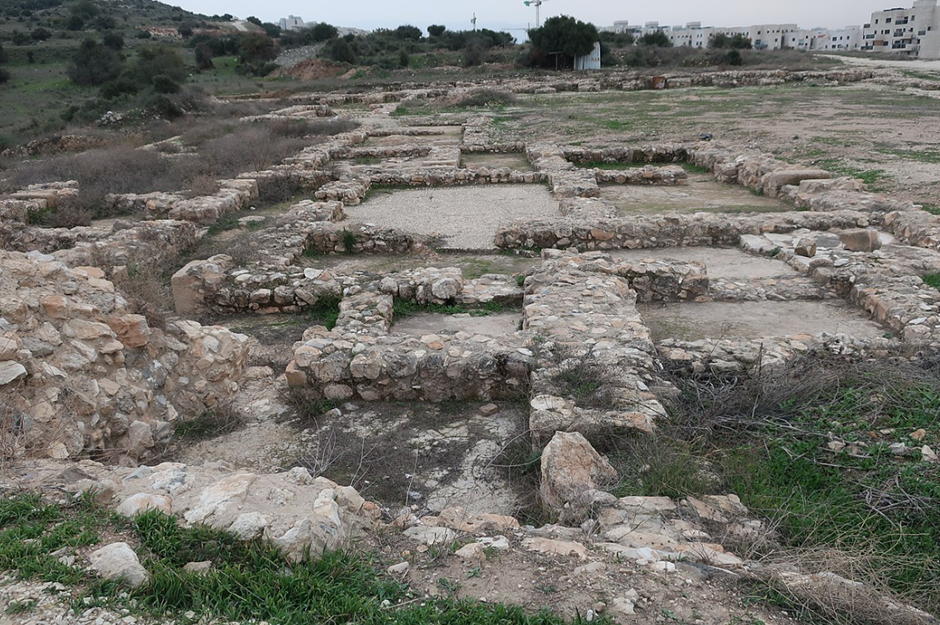“ And it came to pass, when Adonizedek, king of Jerusalem, heard that Joshua had taken Ai, and had completely destroyed it; as he had done to Jericho and her king … and Ai; and … the inhabitants of Gibeon had made peace with Israel…Adonizedek, king of Jerusalem, sent to Hoham, king of Hebron, and to Piram, king of Jarmuth, and Japhia, king of Lachish, and to Debir, king of Eglon, saying, Come up to me and help me, and we will smite Gibeon, for it has made peace with Joshua and with the children of Israel. (Joshua 10: 1-4)”

When living in Israel, one gets so accustomed to seeing Bible sites at every turn, that you can almost start taking it for granted! Some are well-known, others less so. One of the most impressive sites well below the radar is only a 15-minute walk from my home. I am referring to Jarmuth (Tel Yarmut), mentioned 7 times in the Bible. Its remains are among the world’s oldest, and the panoramic views on a clear day afford a view of much of Israel that includes Tel Aviv, Ashdod, and the Mediterranean Sea on one side, and the Judean Mountains (in the environ of Jerusalem) on the other side. Let us explore this wonderous, ancient city together!

When I bring my tourists here, we almost always have the site to ourselves. The city was first founded in the early Bronze age (circa 3050 BCE – 2400 BCE) by the early Canaanites, which is when the first urban cities with walls began to appear in Israel. Although most cities from that time (while organized) were rarely large, this city was an exception. It was about 40 acres (in comparison Jerusalem at the time of King David, over a thousand years later, was only about 15 acres). The palace alone was a whopping 1.5 acres, unheard of from that time!

Photo Credit: Davidbena – CC BY-SA 4.0
The city walls were massive (the Greeks called the massive rocks that made up the structure “Cyclops Stones” because they were so large that only someone with the strength of Cyclops would be able to build something like this). Due to the height difference between the palace and the surrounding topography, which was much lower, a series of elaborate platforms were built leading from the ground level to the city gate. The width of road leading there was 38.5 meters thick (as wide as a multi-lane highway today). The gate is still remarkably well-preserved.

Around 2400 BCE, most of the urbanized Canaanite cities were abandoned (to this day, the reason is not so clear why, although there are several theories). The economy collapsed, and people returned to a more rural, nomadic lifestyle. Jarmuth was no exception.

Photo Credit: Bukvoed – CC BY 4.0
For the next 1000 years, the city lay more or less in ruins (with perhaps some light settlement). In the later Canaanite period (not too long before Joshua brought the Children of Israel back to Israel), the city was re-established. Although the city seems to have flourished (there were pottery shards found from faraway places, suggesting that they were involved in trade) the city was much smaller and confined to the Acropolis. The lower city area including the palace was not resettled, which is one of the reasons why its remains are still in great shape since no one built on top of it. It is the city from this time period that is first mentioned in the Bible.

The city (like most major Canaanite cities) had its own King. After Joshua successfully conquered Jericho and Ai, the powerful city of Gibeon made an alliance with the Children of Israel. Five Canaanite kings attacked Gibeon. sending a message that making peace with the Children of Israel was not in their best interest. When they attacked, Joshua felt bound by his oath and came to their rescue. As the armies of the five kings saw him coming, G-d put panic into their hearts and they were smitten, with the survivors fleeing by way of the “Ascent of Beth-horon”. As they began descending from Beth-Horon, G-d sent a hailstorm that finished off most of the remaining troops (Joshua 10). According to Jewish sources, these actual hailstones were left over from the plague of hail in Egypt. When Moses asked G-d to stop the plague (see Exodus 9:33) the remaining hail was saved. With the death of most of the Canaanite troops, the remainder fled westward through the Ayalon valley and the sun was quickly setting (according to Jewish sources, it was Friday evening and therefore almost Shabbat). In order to take care of the job before sundown, Joshua prayed to G-d for the sun to stand still (which it did) and it didn’t set until the enemies had been destroyed and the war was over. The King of Jarmuth (along with the four other kings) was found hiding in a cave. Joshua ordered that they be brought to him, and then personally slew them (see Joshua 10).

Photo Credit: Natritmeyer – Creative Commons Attribution-Share Alike 4.0 International
The conquered city of Jarmuth was given to the tribe of Judah (see Joshua 15:35). In 422 BCE (some historians say 586 BCE) Jerusalem was destroyed, its people exiled and the cities of Judah, including Jarmuth, became desolate. About 50 years later, during the days of Ezra and Nehemiah, the Jewish people were permitted by the Persians (who now controlled Israel) to return to their homeland. One of the towns resettled was Jarmuth (see Nehemiah 11:29). The city continued to be in existence until the Byzantine period (circa 4th Century CE) when it was abandoned. The town was never rebuilt, but the intriguing Biblical ruins can be visited and enjoyed on your next visit to Israel!
Please visit the author’s site: https://guidedtoursofisrael.com






![Why You Shouldn’t Be Afraid of G-d – Soul Talk [audio]](https://c622d1ec.delivery.rocketcdn.me/wp-content/uploads/2025/03/light-4681014_640-218x150.jpg)
![Modesty & Matzah – Pull Up a Chair [audio]](https://c622d1ec.delivery.rocketcdn.me/wp-content/uploads/2025/03/matzah-1566456_640-218x150.jpg)
















